As promised, here is part II of 2018’s compilation of Facts,
Figures, and Forecasts (F3). The source citations are at the very
end.
Here are the data listings in this order:
- Here’s a listing of the world’s
top defense contractors
- Level of Chinese aviation
expansion revealed by CAAC statistics
- Number of successful ejections
equating to lives saved by Martin Baker Ejection Seats
- Total MRO demand for ATA chapter
25 is $3.7 Billion for 2018 and 2019
- Boeing: 128,500 pilots to be
needed in China by 2037
- IATA: First time ever passenger
numbers exceed 4 billion
- ICAO releases 2018 safety report
- Boeing forecasts air cargo traffic
to double in 20 years
- The future of low cost
- Lasers being pointed at aircraft
- Air transport supports 65.5
million jobs and $2.7 trillion in economic activity
- Airbus: China will need more than
7,400 new aircraft in the next 20 years
- India: new airport and travel
activity
- General Aviation Aircraft
manufacturing outlook positive for 2019
- Airbus: Fleet in Russia and CIS to
double by 2037
- Facts about the FAA and Air
Traffic Control
- IAG’s Busiest Intercontinental
Routes
- Global survey reveals anticipated
significant growth in aviation jobs
- And you though your travel budget
was high?
- Russian Military Aircraft Fleet
- New Entrants for Electric
Propulsion
- How Large is the Global Aerospace
Industry?
- Africa becoming new opportunity
continent for emerging airlines
- NATO Aircraft Distribution
Here’s a
listing of the world’s top defense contractors1:
| Rank |
Company |
Country |
2017 Defense
Revenue* (in millions) |
Revenue From
Defense |
| 1 |
Lockheed Martin 1 |
U.S. |
$47,985.00 |
94% |
| 2 |
Raytheon Company 1 |
U.S. |
$23,573.64 |
93% |
| 3 |
BAE Systems |
U.K. |
$22,380.04 |
88% |
| 4 |
Northrop Grumman 2 |
U.S. |
$21,700.00 |
84% |
| 5 |
Boeing 3 |
U.S. |
$20,561.00 |
22% |
| 6 |
General Dynamics 4 |
U.S. |
$19,587.00 |
63% |
| 7 |
Airbus |
Netherlands/France |
$11,185.91 |
15% |
| 8 |
Almaz-Antey 5 |
Russia |
$9,125.02 |
100% |
| 9 |
Thales |
France |
$8,926.13 |
50% |
| 10 |
Leonardo |
Italy |
$8,856.48 |
68% |
| 11 |
United Technologies |
U.S. |
$7,826.00 |
13% |
| 12 |
L3 Technologies |
U.S. |
$7,749.00 |
81% |
| 13 |
Huntington Ingalls Industries |
U.S. |
$7,030.00 |
95% |
| 14 |
United Aircraft Corp. 7 |
Russia |
$6,197.25 |
80% |
| 15 |
Leidos |
U.S. |
$5,218.00 |
51% |
| 16 |
Rolls-Royce |
U.K. |
$4,625.73 |
16% |
| 17 |
Booz Allen Hamilton |
U.S. |
$4,320.00 |
70% |
| 18 |
Naval Group |
France |
$4,178.33 |
100% |
| 19 |
Harris Corporation |
U.S. |
$4,158.00 |
70% |
| 20 |
Textron Inc. |
U.S. |
$4,117.42 |
29% |
Level of
Chinese aviation expansion revealed by CAAC statistics2
- According to the Civil Aviation
Administration of China (CAAC), 93 new general aviation airports were licensed
in the first half of 2018, more than doubling the number of general aviation
airports in the country. China now has 231 civil airports in a total of 404
airports which support the take-off and landing of general aviation aircraft.
- 118 new general aviation aircraft
were registered with the CAAC in the first half of the year, bringing the
country’s total to 2,415 with a 9.5-percent year-on-year increase.
- Currently, China has direct air
routes with 45 countries alongside the Belt and Road, operating roughly 5,100
flights per week. CAAC has also signed documents with the Czech Republic,
Kazakhstan, New Zealand and Australia to secure civil aviation cooperation.
Number of
successful ejections equating to lives saved by Martin Baker Ejection Seats3
Total MRO
demand for ATA chapter 25 is $3.7 Billion for 2018 and 20194
- Over the next two years,
commercial, regional and business aircraft will go through $3,700,958,983 worth
of total MRO demand.
- ATA chapter 25 is comprised of :
Flight Compartment, Passenger Compartment, Buffet/Galley, Lavatories, Cargo
Compartments, Emergency, Accessory Compartments, Power Drive Units, Coffee
Makers, Water Heaters, Boilers, Etc.
Boeing:
128,500 pilots to be needed in China by 20375
- Boeing reports that the Asia
Pacific region will have the greatest global demand for new civil aviation
personnel over the next 20 years. The region is projected to account for 33
percent of the global need for pilots, 34 percent for technicians and 36
percent for cabin crew.
- Forty percent of all new passenger
airplane deliveries in the next 20 years will be delivered to airlines in the
Asia Pacific, also making the region leading in personnel demand, according to
2018 Boeing Pilot & Technician Outlook - an industry forecast, tied to
projections for new airplane deliveries.
- New commercial technician demand
decreased five percent to 242,000. This is due to advancements in product
development on the 737 MAX, which have resulted in increased maintenance
efficiencies. Overall, maintenance hours required over the life of the airplane
will be reduced.
- New commercial cabin crew demand
increased three percent to 317,000 due to anticipated fleet mix, cabin
configuration and regulatory requirements.
- Including the demand in the
helicopter and business aviation markets, 261,000 pilots, 257,000 technicians
and 321,000 cabin crew will be needed in the region.
- Leading the region in projected
demand for new pilots, technicians and cabin crew:
- China: 128,500 pilots; 126,750
technicians; 147,250 cabin crew
- Southeast Asia: 48,500 pilots;
54,000 technicians; 76,250 cabin crew
- South Asia: 42,750 pilots; 35,000
technicians; 43,250 cabin crew
IATA: First time ever passenger
numbers exceed 4 billion6
Worldwide annual air
passenger numbers exceeded four billion for the first time in 2017, the
International Air Transport Association (IATA) announced on September 6, 2018.
In its industry performance statistics for 2017, the association also observes
that airlines connected a record number of cities worldwide, providing regular
services to over 20,000 city pairs in 2017, more than double the level of 1995.
The unprecedented
passenger numbers growth is supported by a broad-based improvement in global
economic conditions and lower average airfares, according to IATA. “In 2000,
the average citizen flew just once every 43 months. In 2017, the figure was
once every 22 months,” said Alexandre de Juniac, IATA’s Director General and
CEO.
The association also
provides the following data of the 2017 airline industry performance:
Passenger
- System-wide,
airlines carried 4.1 billion passengers on scheduled services, an increase of
7.3% over 2016, representing an additional 280 million trips by air.
- Airlines
in the Asia-Pacific region once again carried the largest number of passengers.
The regional rankings (based on total passengers carried on scheduled services
by airlines registered in that region) are:
1. Asia-Pacific 36.3% market share (1.5 billion passengers, an increase of
10.6% compared to the region’s passengers in 2016)
2. Europe 26.3% market share (1.1 billion passengers, up 8.2% over
2016)
3. North America 23% market share (941.8 million, up 3.2% over 2016)
4. Latin America 7% market share (286.1 million, up 4.1% over 2016)
5. Middle East 5.3% market share (216.1 million, an increase of 4.6% over
2016)
6. Africa 2.2% market share (88.5 million, up 6.6% over 2016).
- The
top five airlines ranked by total scheduled passenger kilometers flown, were:
1. American
Airlines (324 million)
2. Delta Air Lines (316.3 million)
3. United Airlines (311 million)
4. Emirates Airline (289 million)
5. Southwest Airlines (207.7 million)
- The
top five international/regional passenger airport-pairs** were all within the
Asia-Pacific region, again this year:
1. Hong Kong-Taipei Taoyuan
(5.4 million, up 1.8% from 2016)
2. Jakarta Soekarno-Hatta-Singapore (3.3 million, up 0.8% from 2016)
3. Bangkok Suvarnabhumi-Hong Kong (3.1 million, increase of 3.5% from
2016)
4. Kuala Lumpur–Singapore (2.8 million, down. 0.3% from 2016)
5. Hong Kong-Seoul Incheon (2.7 million, down 2.2% from 2016)
- The
top five domestic passenger airport-pairs** were also all in the Asia-Pacific
region:
1. Jeju-Seoul Gimpo (13.5
million, up 14.8% over 2016)
2. Melbourne Tullamarine-Sydney (7.8 million, up 0.4% from 2016)
3. Fukuoka-Tokyo Haneda (7.6 million, an increase of 6.1% from
2016)
4. Sapporo-Tokyo Haneda (7.4 million, up 4.6% from 2016)
5. Beijing Capital-Shanghai Hongqiao (6.4 million, up 1.9% from 2016)
- One
of the interesting recent additions to the WATS report is the ranking of
passenger traffic by nationality, for international and domestic travel.
(Nationality refers to the passenger’s citizenship as opposed to the country of
residence.)
1. United States of America
(632 million, representing 18.6% of all passengers)
2. People’s Republic of China (555 million or 16.3% of all
passengers)
3. India (161.5 million or 4.7% of all passengers)
4. United Kingdom (147 million or 4.3% of all passengers)
5. Germany (114.4 million or 3.4% of all passengers)
Cargo
- Globally,
cargo markets showed a 9.9% expansion in freight and mail tonne kilometers
(FTKs). This outstripped a capacity increase of 5.3% increasing freight load
factor by 2.1%.
- The
top five airlines ranked by scheduled freight tonne kilometers flown were:
1. Federal Express (16.9 billion)
2. Emirates (12.7 billion)
3. United Parcel Service (11.9 billion)
4. Qatar Airways (11 billion)
5. Cathay Pacific Airways (10.8 billion)
Airline
Alliances
- Star Alliance
maintained its position as the largest airline alliance in 2017 with 22%
of total scheduled traffic (in RPKs), followed by SkyTeam (19%) and oneworld
(16%).
ICAO releases 2018 safety report7
- The
International Civil Aviation Organization (ICAO) observes a general trend of
lower number of fatal accidents and fatalities over the past ten years,
according to the findings in its 2018 edition of its Safety Report, released
this week.
The report summarizes the organizations safety
initiatives in 2017 and provides safety performance indicators in 2013–2017.
- In 2017,
there were 4.1 billion passengers travelling by air worldwide on scheduled
commercial services, the organization summarized in a statement released on
September 5, 2018. ICAO accounts 5 fatal accidents and 50 passenger deaths in
2017, putting the commercial aviation safety rate at 12.2 fatalities per
billion passengers and confirming its previous proclaim that 2017 was the
safest year on the record in aviation history.
ICAO claims it remains “particularly focused on its
safety priorities”, including Runway Safety, Controlled Flight into Terrain
(CFIT), Loss of Control Inflight (LOCI), and new safety initiatives. In 2018
report, it notes that global average of effective implementation of ICAO
Standards and Recommended Practices increased from 64.7 % in 2016 to 65.5% in
2017.69.19 % of 192 member states have
achieved the 60 % target, set by the Global Aviation Safety Plan (GASP)
2017–2019 edition.
Boeing
forecasts air cargo traffic to double in 20 years8
- Boeing projects air cargo
operators will need more than 2,600 freighters over the next two decades to
keep up with increasing global freight traffic, which is expected to double
with 4.2 percent growth annually.
- The 980 new medium and large freighters
and 1,670 converted freighters will go toward replacing older airplanes and
growing the global fleet to meet demand, according to the new World Air Cargo
Forecast, released by Boeing today at The International Air Cargo Association's
Air Cargo Forum and Exhibition.
- Some of the factors driving the
growth in air cargo include a growing express market in China and the global
rise of e-commerce, which is forecast to increase 20 percent annually to nearly
$5 trillion in 2021 according to Boeing's analysis.
To meet growing market needs, Boeing also forecasts:
- The world freighter fleet will
expand by more than 70 percent, from the current total of 1,870 to 3,260
airplanes.
- Demand for regional express
services in fast-developing economies will boost the standard-body share of the
freighter fleet from 37 percent today to 39 percent.
- 1,170 standard body and 500 medium
wide-body passenger airplanes will be converted into freighters over the next
two decades.
The future
of low cost9 (Article excerpts regarding Low Cost Carriers, LLC’s)
- Today, half a century later, low
cost has become the preferred means of travel for a third of the world's
passengers. It is estimated that in 2027 - that is, within ten years - half of
the nearly 7 billion flights globally will be of this type.
- The consultant OAG estimates that
this year more than 50 percent of travelers from 10 European countries are
already choosing low-cost airlines. Macedonia tops this list; however, the
country that offers most low-cost seats is Spain, with 82.2 million last year.
Meanwhile, Irish airline Ryanair is a leading low cost carrier, but due its
labor problems this year, it can be overtaken by Easyjet. The low cost model
has provided the means of travel to many people, who were previously unable to
do it.
- Another rising phenomenon is the
so-called low-cost, long-range (low-cost long-haul) – a bet, already taken by
Norwegian. 20% of its fleet is currently devoted to such flights, and the
airline is already expanding, by adding subsidiary in Argentina or opening new
transoceanic routes like the one planned between London and Rio de Janeiro.
Lasers being pointed at aircraft10
- Laser strikes on aircraft and
helicopters have risen over the years and laser pointers are increasing in
power and decreasing in price. Lasers can distract and even harm pilots during
critical phases of flight and can cause temporary visual impairment. Over 6750
laser incidents were recorded in the USA in 2017 according to the Federal
Aviation Administration. In 2016 there were over 1750 laser incidents reported
to the UK Civil Aviation Authority and Transport Canada Civil Aviation.
Air
transport supports 65.5 million jobs and $2.7 trillion in economic activity11
- The global air transport sector
supports 65.5 million jobs and $2.7 trillion in global economic activity,
according to new research released today by the Air Transport Action Group
(ATAG).
- "There are over 10 million
women and men working within the industry to make sure 120,000 flights and 12
million passengers a day are guided safely through their journeys. The wider
supply chain, flow-on impacts and jobs in tourism made possible by air transport
show that at least 65.5 million jobs and 3.6% of global economic activity are
supported by our industry."
Key facts outlined in Aviation: Benefits Beyond Borders,
include:
- -Air transport supports 65.5
million jobs and $2.7 trillion in global economic activity.
- -Over 10 million people work
directly for the industry itself.
- -Air travel carries 35% of world
trade by value ($6.0 trillion worth in 2017), but less than 1% by volume (62
million tonnes in 2017).
- -Airfares today are around 90%
lower than the same journey would have cost in 1950 – this has enabled access
to air travel by greater sections of the population.
- -If aviation was a country, it
would have the 20th largest economy in the world – around the same size as
Switzerland or Argentina.
- -Aviation jobs are, on average,
4.4 times more productive than other jobs in the economy.
- -Scope of the industry: 1,303
airlines fly 31,717 aircraft on 45,091 routes between 3,759 airports in
airspace managed by 170 air navigation service providers.
- -57% of world tourists travel to
their destinations by air.
Airbus:
China will need more than 7,400 new aircraft in the next 20 years12
- China will need over 7,400 new
passenger aircraft and freighters from 2018 to 2037, with a total market value
of US $1,060 billion, according to Airbus’ latest China Market Forecast. It
represents more than 19% of the world total demand for over 37,400 new aircraft
in the next 20 years.
India: new
airport and travel activity13
- Kishangarh is one of 34 airports
opened in the past 18 months in India, whose aviation sector has exploded in
the wake of massive economic growth. In September, the civil aviation minister
said that $60 billion has been budgeted for 100 more in the next 10 to 15
years.
- By 2024, the IATA estimates, India
will rank behind only China and the United States in terms of air traffic to,
from and within the country.
General
Aviation Aircraft manufacturing outlook positive for 201914
The General Aviation Manufacturers Association expressed
optimism about the industry’s prospects for 2019.
- The piston rotorcraft delivery
number of 220 units headlined the year-to-date figures, and marked a
15.8-percent increase from 2017’s third-quarter figure of 190 units delivered.
Turbine rotorcraft shipments accelerated by 8.3 percent, from 471 units
delivered to 510.
- The 784 piston airplanes
deliveries marked an improvement over the comparable 2017 period’s tally of
724, for a gain of 8.3 percent. Turboprop airplane shipments came in at 395 for
a 5.6-percent increase over the 374 deliveries of the first three quarters of
2017.
- Business jet shipments increased
from 433 to 446, or 3 percent, not far off last year’s totals through three
quarters.
- Looking at selected manufacturers
and results reported by GAMA, Cirrus Aircraft shipped 106 airplanes in the
third quarter consisting of 90 singles and 16 SF50 Vision jets. Cirrus’s total
shipments for the year to date added up to 303 aircraft.
- Diamond Aircraft had its best
quarter of the year in terms of shipments with 14 twin-engine DA–42 and 15
DA–62 models accounting for 76 percent of the quarter’s total.
- Brazilian manufacturer Embraer
shipped 15 Phenom 300 10-seat jets during the quarter; the aircraft has been
noted as an emerging sector leader and has accounted for 24 of the company’s 55
overall aircraft shipments year to date, or 44 percent.
- Swiss manufacturer Pilatus shipped
27 aircraft in the quarter, consisting of 20 PC–12 single-engine turboprops,
six of its new PC–24 jets, and one STOL workhorse PC–6 Porter. The company has
shipped 62 airplanes to date.
- Among the 65 singles, twins, and
M-class variants shipped by Piper in the third quarter were 34 PA–28–181 Archer
III airplanes, as Piper pursued its declared strategy of focusing on the flight
training marketplace. The activity brought the total of aircraft shipped so far
this year to 152.
- The year’s trend continued in
Textron Aviation’s Cessna unit, where shipments of Skyhawk SP (30) piston
singles and Grand Caravan EX (21) turboprops led the way. Thirteen Citation
Latitude jets shipped in the quarter, with the three models combining to
account for 64 percent of Cessna’s 110 total third-quarter shipments.
- Bell 505 Jet Rangers, the Leonardo
AW139, and Robinson Helicopters’ R44 piston and R66 turbine models showed
strength among rotorcraft, with the Robinson piston helicopter models and
variants representing the majority of the increased rotorcraft deliveries, GAMA
noted for the period.
Airbus: Fleet
in Russia and CIS to double by 203715
According to Airbus’ Global Market Forecast, unveiled at the
Wings of the Future conference in Moscow:
- Russia and CIS’s airlines will
need some 1220 new aircraft valued at US$175 billion in the upcoming 20 years
(2018-2037).
- This means that the passenger fleet
in the region will almost double from 857 aircraft in service today to over
1700 by 2037.
- Over the next 20 years, passenger
traffic in Russia and CIS region will grow at the average rate of 4.1% annually
with Russia being the major contributor to this growth.
- By 2037 the propensity for air
travel in Russia will more than double.
Facts about
the FAA and Air Traffic Control16
- At
any given moment there are more than 5,000 aircraft traversing the U.S. skies.
- The
FAA is a year-round 24/7 operation, responsible for 5.3 million square miles of
U.S. domestic airspace and 24 million square miles of U.S. airspace over the
oceans.
- There
are 43,290 average daily flights in and out of the U.S.
- More
than 14,000 air traffic controllers manage traffic from many of the FAA’s 700
facilities.
- Fifty-five
hundred airway transportation system specialists maintain more than 70,000
pieces of equipment.
- Aviation
contributes $1.6 trillion annually to the U.S. economy and constitutes 5.1
percent of the gross domestic product.
- Aviation
generates 10 million jobs in the U.S. annually.
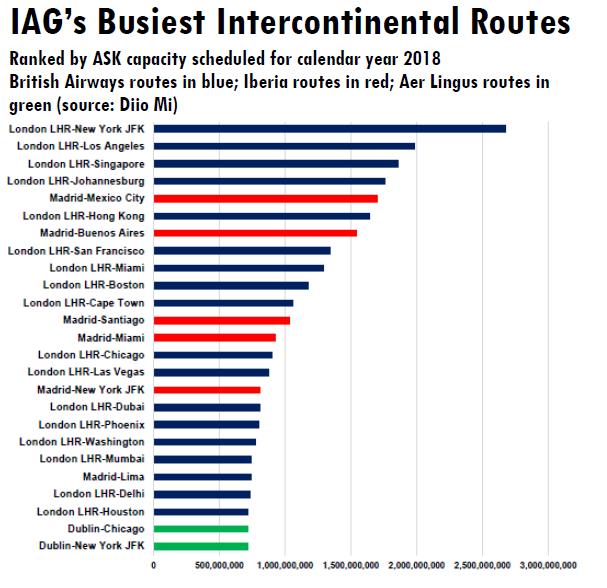
Global
survey reveals anticipated significant growth in aviation jobs18
IATA has revealed the results of a global survey of over 100
leading industry HR professionals at airlines, airports and ground service
providers, carried out by Circle Research to learn more about how HR decision-makers
were managing the retention, training and recruiting of skilled professionals
to fill the anticipated job gaps.
In brief, the results of the report showed that:
- More than 73% of respondents
expect the major areas of job growth to be in ground operations, customer
service and cabin crew.
- 48% reported that finding new
talent is a challenge, through lack of availability of candidates with the
right skill levels and qualifications, plus salary demands of new applicants.
- In addition to the salary and benefits
package of each employee, the HR professionals identified career progression
opportunities (49%) and development and training (33%) as high priorities in
job satisfaction and retention.
- Only 28% of respondents reported
that current training is effective, with many organizations seeking to
complement their in-house training with external partners to improve the
effectiveness of the training.
- Safety and customer service skills
are priorities for hiring managers across the industry. While technology is
indeed changing the customer service role, it is not replacing it.
- Approximately 75% of respondents
expected an increase in customer service, ground operations and cabin crew jobs
over the next two years.
- That is higher than the 65% of
respondents that expect growth in security jobs and 63% that expect growth in
regulatory positions.
And you
though your travel budget was high?Source noted
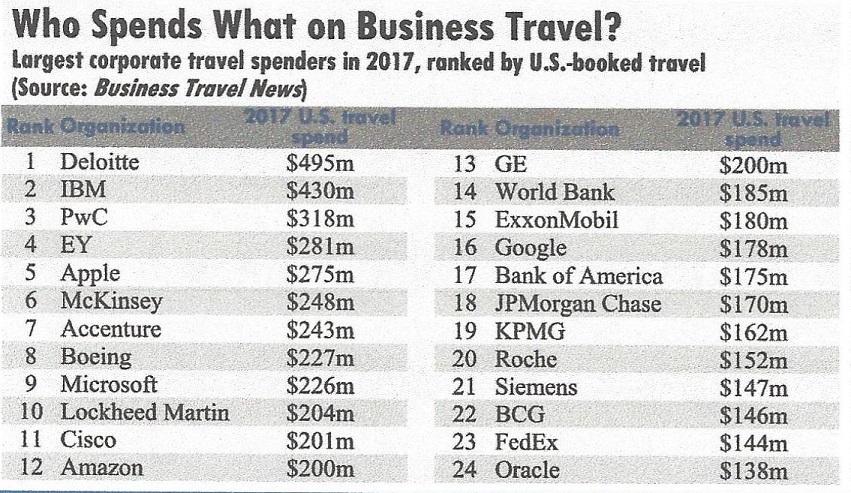
Russian Military Aircraft Fleet19
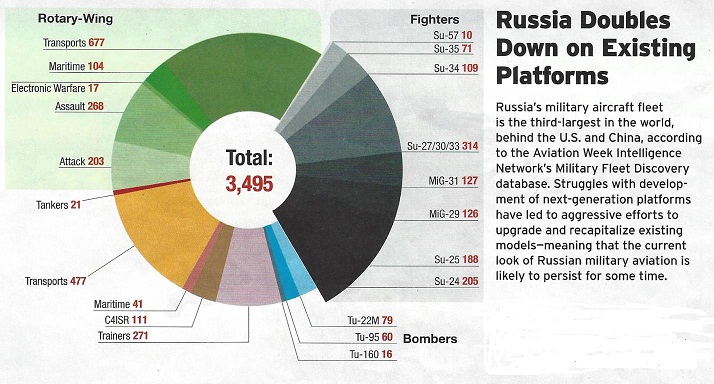
New
Entrants for Electric Propulsion20
- Almost 100 electrically propelled
aircraft are in development worldwide.
- 60% of these are being conducted by
startups, the rest are traditional aerospace incumbents.
How Large is the Global Aerospace Industry? 21
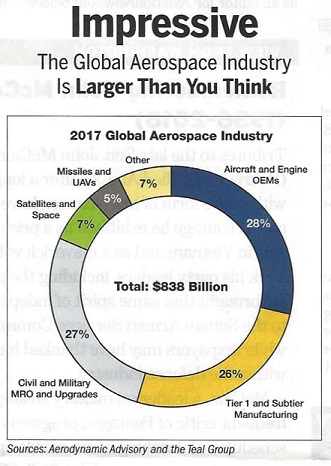
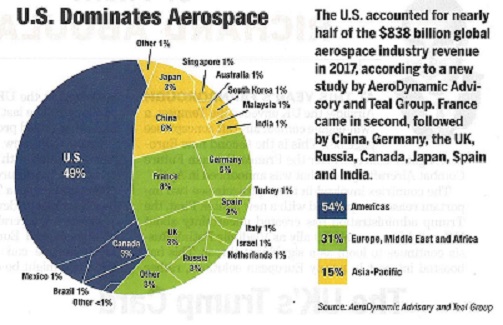
Africa becoming new opportunity continent for emerging
airlines22
- According to the data from IATA,
Africa is home to 16% of the world’s population but it accounts for only 2.20%
of the global air service market.
- According to data available from IATA
the Revenue Passengers Kilometer (RPK) grew by 6.3% and the Freight
Tonne-Kilometres (FTK) grew by 24.8%, the highest of any continent.
- Yet, despite these good numbers put up
by Africa indicating strong growth, its traffic share of total passengers
remains the lowest of any continent at only 2.20% of the world share. The
passenger traffic share trend is improving however, compared to 2016 African
airlines saw a 7.5% traffic rise in 2017 but with existing infrastructure capacity
rose at less than half the rate of demand.
- By 2026 passenger numbers are expected
to increase from 100 million to more than 300 million. This explosive growth
corresponds to 5.9% year-on-year growth.
NATO Aircraft Distribution23
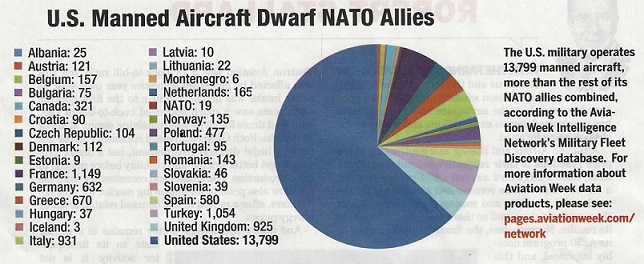
Roy ‘Royboy’
Resto
President/FAA-DAR
www.AimSolutionsConsulting.com
1
http://people.defensenews.com/top-100/
2 Level
of Chinese aviation expansion revealed by CAAC statistics; Avitrader; Daily
Aviation News Alert; Wednesday, August 15th, 2018
3 https://www.linkedin.com/feed/update/activity:6437...
4 https://www.skylinkintl.com/blog/the-two-year-mro-...
5 https://www.aerotime.aero/aerotime.team/21705-boei...
6 https://www.aerotime.aero/aerotime.team/21775-iata...
7 https://www.aerotime.aero/aerotime.team/21784-icao...
8 https://www.aerotime.aero/aerotime.team/21986-boei...
9 https://www.aerotime.aero/aerotime.team/21998-the-...
10 https://www.avitrader.com/2018/10/23/satair-and-me...
11 http://speednews.com/Article/115981?NL=SPD-01&Issu...
12 https://www.avitrader.com/2018/11/08/china-will-ne...
13 https://www.washingtonpost.com/world/asia_pacific/...
14 https://www.aopa.org/news-and-media/all-news/2018/...
15https://www.avitrader.com/2018/11/21/fleet-in-russ...
16
https://www.faa.gov/news/fact_sheets/news_story.c...
17 Airline
Weekly, Oct 22, 2018, Issue 692, Page 5
18
https://www.avitrader.com/2018/08/20/global-surve...
19
Aviation Week & Space Technology; September 17-30, 2018, page 10
20
Aviation Week & Space Technology; September 3-16, 2018, page 28
21 Aviation Week
& Space Technology; September 3-16, 2018, page 12
Aviation Week & Space Technology;
July 30-August 19, 2018, page 11
22https://www.aerotime.aero/aerotime.team/21642-afri...
23 Aviation Week & Space Technology; August 20-September
2, 2018, page 11

